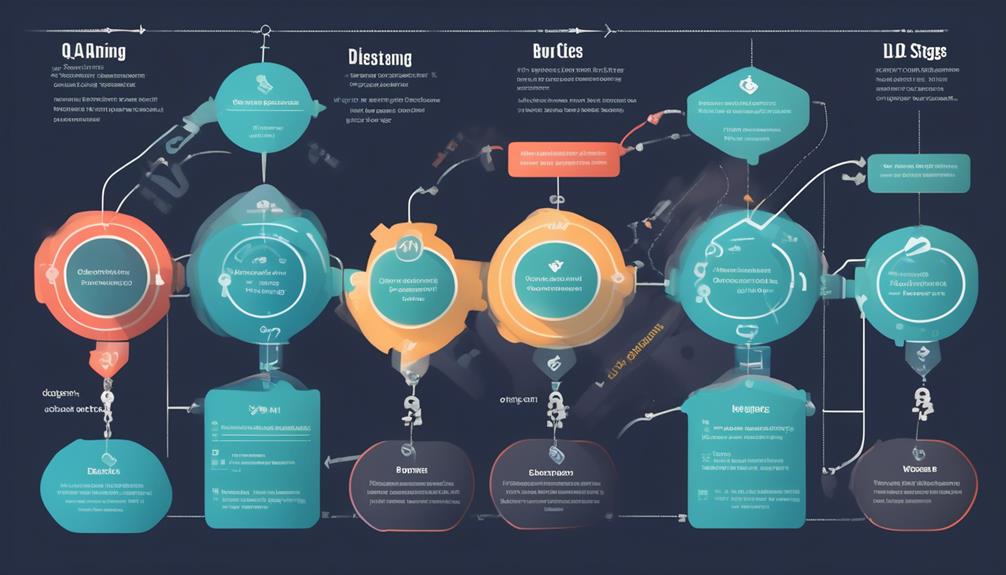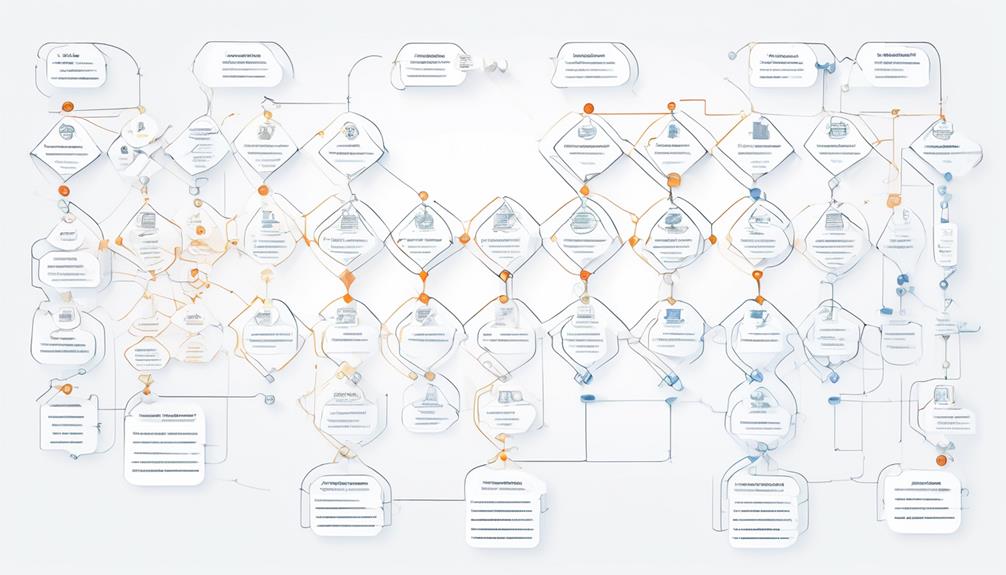We have all experienced the frustration of software glitches disrupting our work, like when the payroll system crashed just before the end-of-month deadline.
Quality assurance (QA) in the software development life cycle is crucial for ensuring that such situations are minimized or even avoided altogether.
But have you ever wondered just how QA impacts the entire software development process and the end product?
Let’s explore the significance of QA in the SDLC and how it influences the overall quality of software, from its inception to its deployment.
Key Takeaways
- QA plays a crucial role in ensuring planned functionality and bug-free software throughout the SDLC.
- QA optimization and integration enhance product quality, streamline processes, and drive continuous improvement.
- QA teams, whether in-house or outsourced, contribute to smooth deployment, ongoing support, and customer satisfaction.
- QA’s involvement in various stages of development, collaboration with design teams, and focus on user experience directly impact the success of the product.
Significance of QA in SDLC
In the software development life cycle, the significance of QA can’t be overstated as it ensures the planned functionality of the software is met and that it’s free from bugs, thus profoundly impacting the overall quality of the end product.
Quality Assurance (QA) is integral at every stage of the SDLC, starting from the design phase. By actively participating in the design phase, QA prevents wastage of time and resources by identifying potential flaws early, ultimately contributing to the development of a superior end product.
Throughout the testing phase, QA’s role extends beyond executing tests. It ensures that the software meets the highest quality standards before release, significantly influencing customer satisfaction.
Furthermore, QA’s involvement guarantees smooth deployment of the software and ongoing support for bug fixes and updates, ensuring the software’s quality and reliability throughout its lifecycle.
QA’s contribution to each stage of the software development life cycle not only ensures the current quality of the product but also drives continuous improvement and innovation in software development. The importance of QA in SDLC is undeniable, as it directly impacts the success and reputation of the software product.
Key Stages of QA in SDLC

Ensuring the planned functionality of the software is met and that it’s free from bugs, QA’s involvement is crucial at every stage of the software development life cycle, particularly in the key stages of QA in SDLC.
The key stages of QA in SDLC are as follows:
- Planning and Design Phase:
- QA involvement in this phase ensures that potential issues are identified early, saving time and money by avoiding design and development waste.
- By catching errors before the product release, QA improves customer satisfaction and helps meet industry standards and regulatory requirements.
- Testing Phase:
- QA plays a crucial role in ensuring the quality of the software before release, saving time and money by avoiding post-release bug fixes and updates.
- QA’s meticulous testing process ensures that the software meets planned functionality and is bug-free, providing a seamless user experience.
QA Impact on Software Development
We’re now set to explore the impact of QA on software development. This will involve examining the key points of testing process optimization, quality assurance integration, and development cycle efficiency. Understanding the significance of these aspects is crucial as it sheds light on how QA practices shape the software development process and lead to better outcomes.
Testing Process Optimization
Throughout the software development life cycle, testing process optimization plays a crucial role in ensuring the efficiency and effectiveness of QA’s impact on software development. This optimization enhances the overall product quality and accelerates the SDLC by leveraging automation tools and refining the QA process.
The meticulous selection and implementation of appropriate testing methodologies and tools streamline the software development processes, leading to quicker identification and resolution of defects. Additionally, it empowers the QA team to focus on critical areas, thus elevating the product quality and customer satisfaction.
The optimization of testing processes not only fosters a culture of continuous improvement within the QA role but also fosters a deeper integration of QA activities, ensuring a comprehensive approach to product quality.
Quality Assurance Integration
During the planning and design phases, the integration of Quality Assurance (QA) significantly contributes to saving time and resources by identifying potential design and development inefficiencies. QA Engineers play a vital role in providing insights on different implementation methods and assessing potential impacts on user experience during the implementation phase.
In the testing stage, QA’s responsibilities extend beyond executing tests; they meticulously write detailed test cases, keep track of updates, and prioritize supported browsers and devices. Furthermore, QA ensures smooth deployment of the software and ongoing support for bug fixes and updates in the deployment and maintenance phases.
Their integration with the development team ensures software quality, reliability, and customer satisfaction at every stage of the software development life cycle. An in-house QA team is crucial for efficiently fulfilling these roles and responsibilities within the SDLC.
Development Cycle Efficiency
In optimizing the development cycle efficiency, Quality Assurance (QA) plays a pivotal role in identifying and rectifying potential inefficiencies in the software development process, thereby contributing to time and resource savings.
- QA specialists meticulously analyze product requirements, ensuring alignment with the SDLC process. This evokes a sense of assurance and precision, knowing that QA specialists are dedicated to thorough analysis and alignment.
- Automated testing, integrated into the quality management system, enhances the efficiency of the software testing phase. This elicits a feeling of confidence and reliance on advanced technological solutions for streamlined processes.
Bug Identification and Defect Resolution

Thorough testing and analysis are essential for identifying bugs within the software product. As QA Analysts, we play a critical role in bug identification and defect resolution throughout the Software Development Life Cycle (SDLC). Our meticulous approach involves creating comprehensive test cases to uncover potential issues, ensuring that engineers have the necessary information to reproduce and understand the defects. Once identified, we collaborate with the QA Lead, developers, and stakeholders to prioritize bug fixes based on severity and impact. Detailed bug reports are crucial, providing clear steps to replicate the issues and aiding in efficient defect resolution.
Effective defect resolution requires continuous communication and collaboration. We work closely with developers to ensure that fixes are implemented and thoroughly tested. Our role extends to validating the fixes and preventing regression through comprehensive retesting. This rigorous approach to bug identification and defect resolution ensures that the software product meets high-quality standards and fulfills stakeholder expectations.
User Satisfaction and QA

As QA Analysts deeply embed user satisfaction as a pivotal metric in our efforts, ensuring that the software product meets high-quality standards becomes intricately linked with addressing issues that impact user satisfaction. This connection emphasizes the crucial role of Quality Assurance (QA) in the Software Development Life Cycle (SDLC) and underscores the importance of QA teams in delivering an exceptional user experience.
To achieve this, QA teams must actively engage in various stages of product development, collaborating closely with design teams and maintaining continuous involvement in testing, deployment, and maintenance phases. By doing so, QA can directly impact customer satisfaction and overall product success.
This level of involvement not only demonstrates the significance of QA in ensuring user satisfaction but also highlights the emotional investment and dedication of QA professionals to delivering a superior product experience. As QA analysts, we understand that our role goes beyond technical validation; it encompasses a deep commitment to ensuring user satisfaction, which ultimately defines the success of the product.
Roles and Responsibilities in QA Teams

Advocating for user experience and providing expertise in the planning and design phases, QA testers play a crucial role in ensuring the quality of software products.
Throughout the Software Development Life Cycle (SDLC), QA testers actively participate in various stages to uphold quality standards.
In the planning phase, QA analyzes product requirements and collaborates with developers to ensure that the software meets user expectations.
During the implementation phase, QA provides insights on different implementation methods and assesses potential impacts on user experience.
In the testing phase, QA’s responsibilities extend beyond executing tests to include writing detailed test cases and bug reports. Furthermore, they contribute to the smooth deployment of the software by verifying all features and functionalities.
Additionally, QA testers play a vital role in ongoing maintenance by providing support for bug fixes and updates. They also collect project metrics and analyze user feedback throughout the product development life cycle.
Lastly, QA teams are responsible for creating and maintaining automated tests to ensure the efficiency and effectiveness of the testing process.
In-House Vs. Outsourced QA Teams

With a focus on the pivotal role of QA teams in ensuring software quality throughout the SDLC, the comparison between in-house and outsourced QA teams becomes essential for organizations aiming to maximize efficiency and effectiveness. When considering the pros and cons of in-house versus outsourced QA teams, emotions can run high.
Here’s a breakdown to evoke an emotional response in our audience:
- In-House QA Teams
- Feeling of security and control with a team that has a deep understanding of the company’s culture, goals, and products.
- Sense of immediate support and collaboration with the development team, fostering a strong sense of unity and teamwork.
- Outsourced QA Teams
- Excitement and anticipation for fresh perspectives, industry best practices, and global market knowledge brought by external experts.
- Nervousness about potential communication challenges and the need to adapt to a new team’s working style and processes.
Both in-house and outsourced QA teams play a crucial role at every stage of the SDLC, ensuring the product’s quality through manual and automated testing. Understanding the importance of SDLC in delivering high-quality software is vital for organizations to make informed decisions about their QA strategy.
Frequently Asked Questions
What Is QA in Sdlc?
We ensure software quality and functionality are met throughout the development process. Our specialists create and implement strategies for quality improvement, employing various testing types.
We plan the testing process and objectives within the SDLC. Our role is crucial in each stage of the software development life cycle, from planning to deployment and maintenance.
What Is the QA Process Life Cycle?
In the QA process life cycle, we meticulously navigate through planning, designing, implementing, testing, deploying, and maintaining software.
Our thorough approach involves advocating for user experience, mapping out requirements, identifying design issues, and crafting detailed test cases.
We collaborate closely with developers to enhance code quality, ensure smooth deployment, provide ongoing support, and monitor user feedback.
Our mastery in this process ensures software quality at every stage.
What Is the QA Role in Software Development?
In software development, QA plays a crucial role in ensuring the quality and reliability of the product. We contribute by advocating for user experience, providing insights on implementation methods, writing detailed test cases, and collaborating with developers.
Our efforts save money, protect reputation, improve customer satisfaction, and drive continuous improvement and innovation. Our meticulous approach ensures that the software meets specific business needs and is reliable for end users.
What Is the QA Phase of Development?
In the QA phase of development, we meticulously ensure the quality and reliability of the software before release. We write detailed test cases, execute tests, and prioritize supported browsers and devices to guarantee software quality.
Our role is pivotal in deployment and maintenance, verifying software functionality and promptly addressing user feedback. We analyze product requirements, find inconsistencies, and collaborate with developers to plan and execute testing cases.
Conclusion
In conclusion, quality assurance (QA) is the backbone of successful software development life cycle (SDLC).
Just like a skilled conductor leads an orchestra to create harmonious music, QA ensures that every stage of SDLC works seamlessly together to produce bug-free and efficient software.
This orchestration of QA in SDLC results in a productive work environment, satisfied employees, and overall organizational success.
At the helm of our content team is Amelia, our esteemed Editor-in-Chief. Her extensive background in technical writing is matched by her deep-seated passion for technology. Amelia has a remarkable ability to distill complex technical concepts into content that is not only clear and engaging but also easily accessible to a wide range of audiences. Her commitment to maintaining high-quality standards and her keen understanding of what our audience seeks are what make her an invaluable leader at EarnQA. Under Amelia’s stewardship, our content does more than just educate; it inspires and sets new benchmarks in the realm of QA education.










